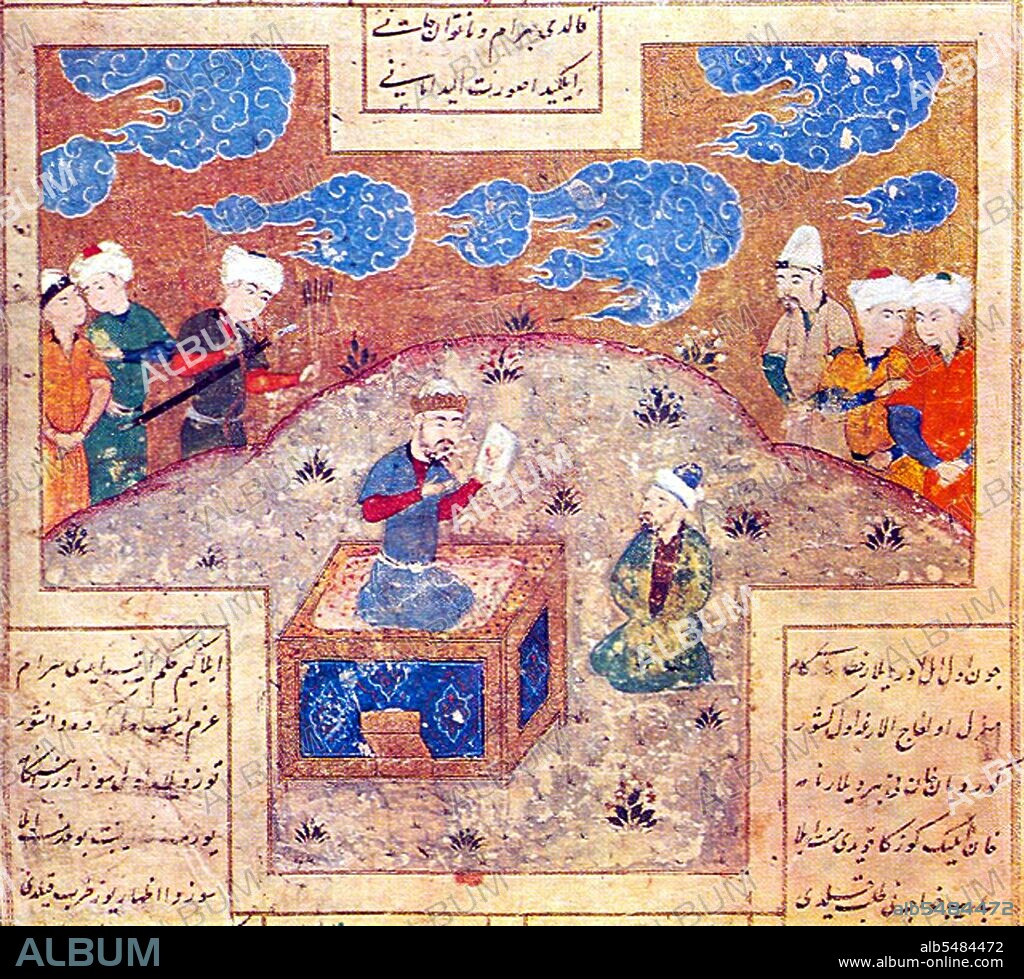alb5484472
Uzbekistan: Mani, the Prophet of Manichaeism, portrayed as a painter presenting King Bahram Gur with a painting. 16th century miniature by Ali Shir Nava'i, Tashkent

|
Add to another lightbox |
|
Add to another lightbox |



Buy this image.
Select the use:

Title:
Uzbekistan: Mani, the Prophet of Manichaeism, portrayed as a painter presenting King Bahram Gur with a painting. 16th century miniature by Ali Shir Nava'i, Tashkent
Caption:
In the medieval Islamic tradition, Mani is described as a painter who set up a sectarian movement in opposition to Zoroastrianism. He was persecuted by Shapur I and fled to Turkestan, where he made disciples and embellished temples with his paintings. Provisioning in advance a cave which had a spring, he told his disciples he was going to heaven, and would not return for a year, after which time they were to seek him in the cave in question. When they went to look for him, he showed them an illustrated book, called Ergenk, or Estenk, which he said he had brought from heaven: whereafter he had many followers, with whom he returned to Persia at the death of Shapur. The new king, Hormisdas, joined and protected the sect; and built Mani a castle. The next king, Bahram or Varanes, at first favoured Mani; but, after getting him to debate with certain Zoroastrian teachers, caused him to be flayed alive, and the skin to be stuffed and hung up. Thereupon most of his followers fled to India, and some even to China, those remaining being reduced to slavery.
Credit:
Album / Pictures From History/Universal Images Group
Releases:
Model: No - Property: No
Rights questions?
Rights questions?
Image size:
4400 x 3981 px | 50.1 MB
Print size:
37.3 x 33.7 cm | 14.7 x 13.3 in (300 dpi)
Keywords:
ANCIENT WORLD • ANT. OR.: IRAN • ANTIGUEDAD • ANTIQUITIES • ANTIQUITY • ART • ARTS • ASIA IMAGE • ASIA PICTURES • ASIA • ASIAN IMAGES • ASIAN PICTURES • ASIAN • GNOSTICISM • HISTORIA UNIVERSAL • HISTORIA • HISTORICAL IMAGES • HISTORICAL PICTURES • HISTORICAL • HISTORY IMAGES • HISTORY PICTURES • HISTORY • IRAN • IRANIAN • LEGEND • MANI THE PAINTER • MANI • MANICHAEAN • MANICHAEISM • MANICHAISM • MINIATURE • MINIATURES • MYTH: PERSIAN • PAINT • PAINTER • PAINTING • PAINTINGS • PERSIA • PERSIAN ART • PERSIAN MYTH • PERSIAN • PROPHET • RELIGION • ROSTAM • RUSTAM BEG • RUSTAM • UZBEK • UZBEKISTAN
 Pinterest
Pinterest Twitter
Twitter Facebook
Facebook Copy link
Copy link Email
Email
